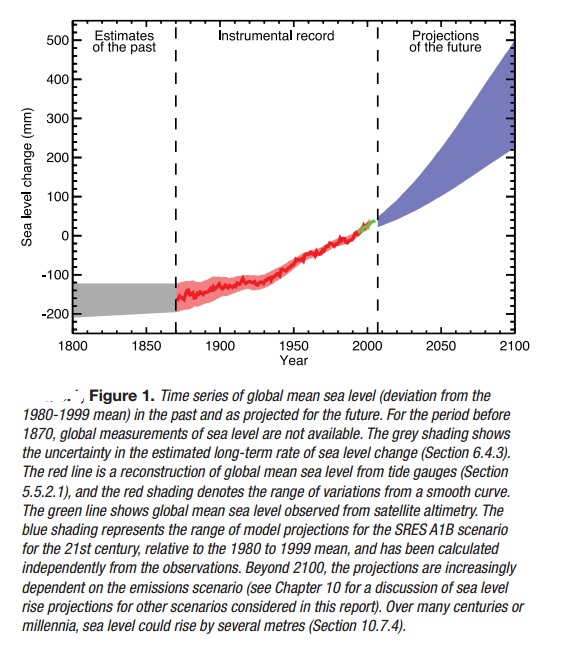Chapter: social science geography student essay writing
Is Sea Level Rising?

Is Sea Level Rising?
Yes, there is strong evidence that global sea level gradually
rose in the 20th century and is currently rising at an increased rate, after a
period of little change between AD 0 and AD 1900. Sea level is projected to
rise at an even greater rate in this century. The two major causes of global
sea level rise are thermal expansion of the oceans (water expands as it warms)
and the loss of land-based ice due to increased melting.
Global sea level rose by about 120 m during the several
millennia that followed the end of the last ice age (approximately 21,000 years
ago), and stabilised between 3,000 and 2,000 years ago. Sea level indicators
suggest that global sea level did not change significantly from then until the
late 19th century. The instrumental record of modern sea level change shows
evidence for onset of sea level rise during the 19th century. Estimates for the
20th century show that global average sea level rose at a rate of about 1.7 mm
yr-1.
Satellite observations available since the early 1990s
provide more accurate sea level data with nearly global coverage. This decade-long
satellite altimetry data set shows that since 1993, sea level has been rising
at a rate of around 3 mm yr-1, significantly higher than the average during the
previous half century. Coastal tide gauge measurements confirm this
observation, and indicate that similar rates have occurred in some earlier
decades.
In agreement with climate models, satellite data and
hydrographic observations show that sea level is not rising uniformly around
the world. In some regions, rates are up to several times the global mean rise,
while in other regions sea level is falling. Substantial spatial variation in
rates of sea level change is also inferred from hydrographic observations.
Spatial variability of the rates of sea level rise is mostly due to non-uniform
changes in temperature and salinity and related to changes in the ocean
circulation.
Near-global ocean temperature data sets made available in
recent years allow a direct calculation of thermal expansion. It is believed
that on average, over the period from 1961 to 2003, thermal expansion
contributed about one-quarter of the observed sea level rise, while melting of
land ice accounted for less than half. Thus, the full magnitude of the observed
sea level rise during that period was not satisfactorily explained by those
data sets, as reported in the IPCC Third Assessment Report.
During recent years (1993-2003), for which the observing
system is much better, thermal expansion and melting of land ice each account
for about half of the observed sea level rise, although there is some
uncertainty in the estimates.
The reasonable agreement in recent years between the observed
rate of sea level rise and the sum of thermal expansion and loss of land ice
suggests an upper limit for the magnitude of change in land-based water
storage, which is relatively poorly known. Model results suggest no net trend
in the storage of water over land due to climate-driven changes but there are
large interannual and decadal fluctuations. However, for the recent period 1993
to 2003, the small discrepancy between observed sea level rise and the sum of
known contributions might be due to unquantified humaninduced processes (e.g.,
groundwater extraction, impoundment in reservoirs, wetland drainage and
deforestation).
Global sea level is projected to rise during the 21st century
at a greater rate than during 1961 to 2003. Under the IPCC Special Report on
Emission Scenarios (SRES) A1B scenario by the mid- 2090s, for instance, global
sea level reaches 0.22 to 0.44 m above 1990 levels, and is rising at about 4 mm
yr-1. As in the past, sea level change in the future will not be geographically
uniform, with regional sea level change varying within about �0.15 m of the
mean in a typical model projection. Thermal expansion is projected to
contribute more than half of the average rise, but land ice will lose mass
increasingly rapidly as the century progresses. An important uncertainty
relates to whether discharge of ice from the ice sheets will continue to
increase as a consequence of accelerated ice flow, as has been observed in
recent years. This would add to the amount of sea level rise, but quantitative
projections of how much it would add cannot be made with confidence, owing to
limited understanding of the relevant processes.
Figure shows the evolution
of global mean sea level in the past and as projected for the 21st century for
the SRES A1B scenario.

Related Topics